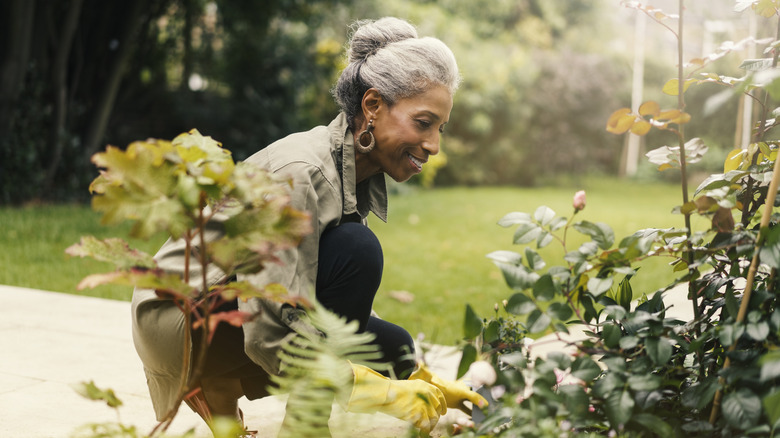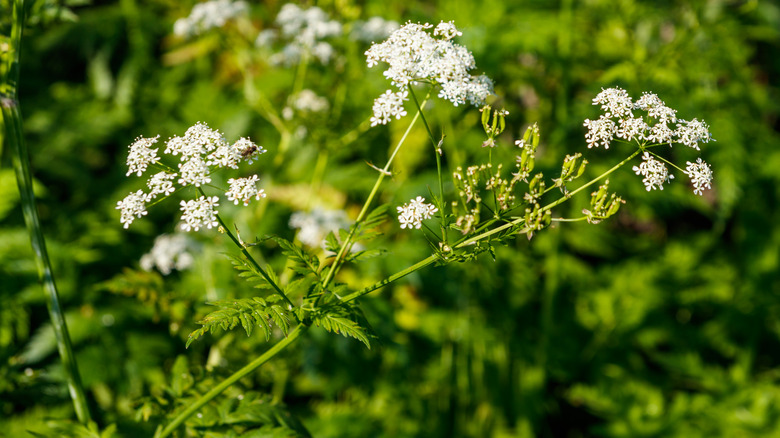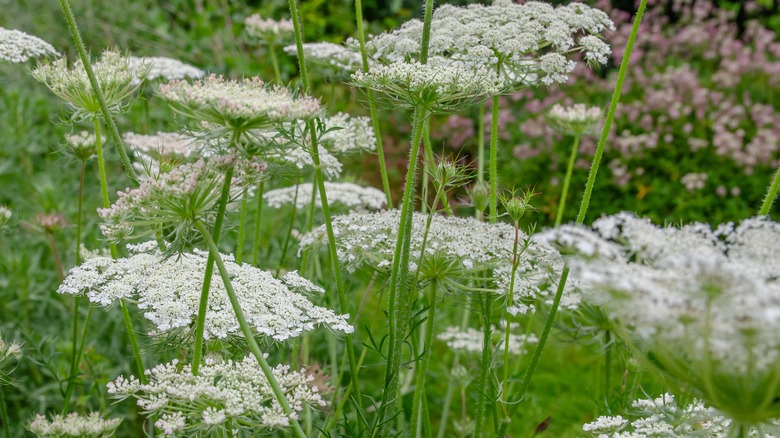Avoid Mistaking This Gorgeous Plant For Its Dangerous Look-Alike
The wild carrot or Queen Anne's Lace (Daucus carota) has a white umbel inflorescence that's fooled many gardeners into thinking they're dealing with the much-dreaded poison hemlock (Conium maculatum). But that's a grave injustice, as unlike the toxic hemlock that should not be consumed, the carrot has edible taproots and looks splendid in floral arrangements. Although both plants are weedy and spread fast, several native pollinators, including black swallowtail caterpillars and adult bees, flock to the Queen Anne's Lace, bolstering their case. So, differentiating between the two Apiaceae family relatives is necessary, lest you remove the incorrect plant. While they look very similar, these plants have different leaf shapes, stem colors, and heights, as well as some other variations in appearance.
While some may try to tell these species apart by looking for the dark purple spot present in the carrots' flowerhead center, this differentiation is far from dependable, as not all varieties exhibit it. That being said, their flower formation is a tad different, with the Queen Anne's Lace growing dense, compound flowers versus the looser, starburst, multiple-flower formation on the hemlock. Moreover, wild carrots bloom in mid-to-late summer, eventually turning inward to take on the shape of a bird's nest (their alternate name). In contrast, poison hemlock flowers in the late spring. If you recognize poison hemlock in your yard, it's important to use caution when removing the taproot or applying herbicides. Wear gloves and thoroughly wash your hands afterwards.
Poison hemlock has darker and larger leaves
As the doppelgangers are biennials (meaning their first year's vegetative growth is succeeded by flowering in the following year), they showcase different tell-tale signs as they grow. In its early stage, Queen Anne's Lace develops 2 to 6-inch long, grayish-green, three-lobed young leaves that are much larger toward the bottom than at the top. These appear smooth and leathery but support several hairy strands along the veins and margins. Curiously, their leaflet's blades are shorter than the petiole, or the point joining the leaf to the stem. Its reproductive system kicks in its second growth year, giving way to a 3-foot long flower stalk.
In comparison, poison hemlock (pictured above) supports relatively darker, broader, sharper, and larger leaves that are sometimes almost 18 inches long. However, the leaves are plainer and far less divided than their gorgeous look-alike. Plus, they're shaped like wedges, in contrast to the straighter or lance-like look found in wild carrots. When crushed, they give off a foul smell, unlike the carrot-like smell that's prominent in Queen Anne's Lace.
Wild carrots have pikes, hemlocks have splotchy stems
Another way to differentiate the two plants from one another is to examine their stems. Wild carrots (pictured above) support 2- to 4-foot-tall flower stems replete with short, tough, and straight hair. They are solid green and fairly sturdy compared to the hollower look of hemlocks. But the poisonous plant makes up for its lack of solidity through its length, which touches anywhere between 3 and 10 feet. What truly gives the poison hemlock away is the purple spotting on the stem. Although some Queen Anne's Lace stems can take on a purplish-red hue as well, they are almost always spread uniformly and are accompanied by coarse hair, unlike hemlock's hairless stems with splotches that are interspersed arbitrarily.
A wild carrot's flowerhead is also defended by short, green pikes, which you wouldn't usually find on hemlock. These can be found underneath the white blooms and face upwards. However, wear gloves before you touch the plant to avoid soaking the oils into your skin. Moreover, if the plants are over 6 feet tall, know you've got hemlock in your yard — in fact, they may grow up to 10 feet tall in moist soils. On the flip side, Queen Anne's Lace plants are shorter (under 3 feet) and thrive in sandy soils or gravelly substrates. Overall, if you're unsure what plant you're dealing with, it's best to ask a professional before touching (and definitely before consuming) either of these plants.


